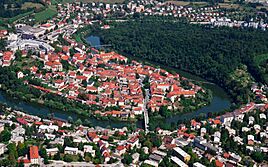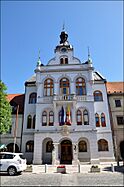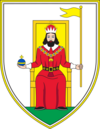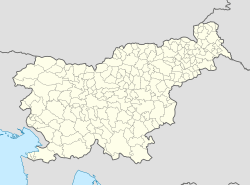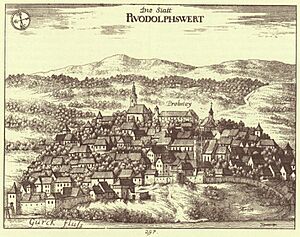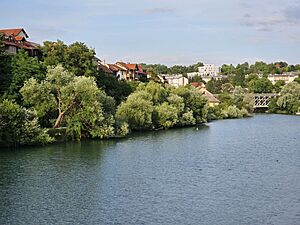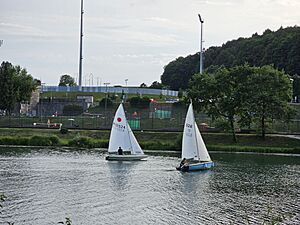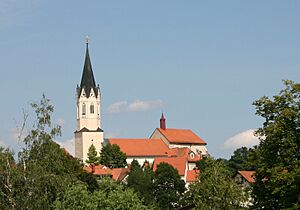Novo Mesto facts for kids
Quick facts for kids
Novo Mesto
Novo mesto
|
|||
|---|---|---|---|
|
Town
|
|||
|
Novo Mesto with the river Krka from the air
Town Hall
St. Leonard's Church
Diocesan Manor
Kandija Bridge
Novo Mesto Cathedral
|
|||
|
|||
| Nickname(s):
City of Situlas
|
|||
| Country | |||
| Traditional region | Lower Carniola | ||
| Statistical region | Southeast Slovenia | ||
| Municipality | Novo Mesto | ||
| Founded | 7 April 1365 as Růdolfswerde |
||
| Founded by | Rudolf IV of Austria | ||
| Area | |||
| • Total | 33.3 km2 (12.9 sq mi) | ||
| Elevation | 181 m (594 ft) | ||
| Population
(2020)
|
|||
| • Total | 24,183 | ||
| • Density | 726.2/km2 (1,880.9/sq mi) | ||
| Time zone | UTC+01 (CET) | ||
| • Summer (DST) | UTC+02 (CEST) | ||
| Postal code |
8000
|
||
| Vehicle registration | NM | ||
| Source: Statistical Office of the Republic of Slovenia, census of 2002. | |||
Novo Mesto is the seventh-largest city in Slovenia. It is an important center for business and culture in the Lower Carniola region, which is in southeastern Slovenia. The city is located on a bend of the Krka River, not far from the border with Croatia.
Contents
What's in a Name?
Novo Mesto was first mentioned in history books in 1365. Back then, it was called Růdolfswerde. This German name means 'Rudolf's island' or 'land above the water'. It was named after Rudolf IV, Duke of Austria, who officially made it a town in 1365.
Another German name, Neustadtl, was also used. This name likely means 'new town', just like the Slovene name Novo mesto. Places named "New Town" are common in Europe. They usually refer to settlements built where an older town was destroyed.
From 1865 to 1918, the town was officially called Rudolfovo in Slovene. After World War I, when Austria-Hungary broke apart, the city became part of the Kingdom of Yugoslavia. That's when it was officially renamed Novo mesto.
A Look at Novo Mesto's Past
Novo Mesto has been a home for people since ancient times. It's one of Europe's most important places for finding artifacts from the Hallstatt culture (Early Iron Age). Because many special ancient containers called situlas were found here, Novo Mesto is known as the "City of Situlas."
The town itself was founded on April 7, 1365, by Rudolf IV, Duke of Austria. He named it Rudolfswerth. The Kandija Bridge, which crosses the Krka River, has connected the city to southern lands since the 1600s. It was first made of wood and later rebuilt with iron in the 1800s.
During World War II, Novo Mesto was controlled by Fascist Italy. Later, it was taken over by Nazi Germany until the war ended.
In 1958, a major motorway was built. It connected Ljubljana, the capital of Slovenia, to Zagreb in Croatia, passing through Novo Mesto. This road, now called the A2 motorway, helped Novo Mesto grow into an important regional center.
Who Lives in Novo Mesto?
Most people living in Novo Mesto are ethnically Slovene. There is also a Roma settlement called Žabjak (also known as Brezje) on the southeast edge of the town.
How the Population Has Grown
| 1948 | 1953 | 1961 | 1971 | 1981 | 1991 | 2002 | 2011 | 2013 | 2015 |
|---|---|---|---|---|---|---|---|---|---|
| 6,645 | 7,526 | 9,873 | 14,144 | 19,741 | 22,333 | 22,415 | 23,341 | 23,212 | 23,317 |
Novo Mesto's Weather
Novo Mesto has a humid continental climate. This means it has warm, humid summers and cold winters. Its weather is affected by the nearby Dinaric Alps, the Alps, and the Adriatic Sea.
Warm, moist air often comes from the Atlantic and Mediterranean. Sometimes, strong winds from the southwest can bring very warm weather. In winter, cold air from Eastern Europe and Siberia can make it very cold and snowy.
The coldest temperature ever recorded was -25.6 °C in 1952. The hottest was 39.9 °C in 2013. It rains a lot, especially from May to November. Snow usually falls between December and February.
| Climate data for Novo Mesto (1991–2020 normals, extremes 1950–2020) | |||||||||||||
|---|---|---|---|---|---|---|---|---|---|---|---|---|---|
| Month | Jan | Feb | Mar | Apr | May | Jun | Jul | Aug | Sep | Oct | Nov | Dec | Year |
| Record high °C (°F) | 17.2 (63.0) |
21.4 (70.5) |
25.8 (78.4) |
29.0 (84.2) |
33.1 (91.6) |
35.2 (95.4) |
38.0 (100.4) |
39.9 (103.8) |
33.0 (91.4) |
28.1 (82.6) |
23.7 (74.7) |
19.8 (67.6) |
39.9 (103.8) |
| Mean daily maximum °C (°F) | 4.7 (40.5) |
7.3 (45.1) |
12.3 (54.1) |
17.2 (63.0) |
21.7 (71.1) |
25.5 (77.9) |
27.6 (81.7) |
27.3 (81.1) |
21.6 (70.9) |
16.2 (61.2) |
10.1 (50.2) |
4.9 (40.8) |
16.4 (61.5) |
| Daily mean °C (°F) | 0.7 (33.3) |
2.1 (35.8) |
6.5 (43.7) |
11.1 (52.0) |
15.6 (60.1) |
19.5 (67.1) |
21.2 (70.2) |
20.5 (68.9) |
15.4 (59.7) |
10.8 (51.4) |
6.1 (43.0) |
1.2 (34.2) |
10.9 (51.6) |
| Mean daily minimum °C (°F) | −2.6 (27.3) |
−2.1 (28.2) |
1.3 (34.3) |
5.4 (41.7) |
9.7 (49.5) |
13.5 (56.3) |
15.1 (59.2) |
15.0 (59.0) |
10.9 (51.6) |
7.0 (44.6) |
3.1 (37.6) |
−1.6 (29.1) |
6.2 (43.2) |
| Record low °C (°F) | −23.5 (−10.3) |
−25.2 (−13.4) |
−22.1 (−7.8) |
−6.9 (19.6) |
−4.2 (24.4) |
1.1 (34.0) |
4.9 (40.8) |
3.9 (39.0) |
−1.1 (30.0) |
−6.6 (20.1) |
−15.0 (5.0) |
−19.6 (−3.3) |
−25.2 (−13.4) |
| Average precipitation mm (inches) | 56 (2.2) |
70 (2.8) |
60 (2.4) |
83 (3.3) |
103 (4.1) |
105 (4.1) |
99 (3.9) |
112 (4.4) |
136 (5.4) |
120 (4.7) |
111 (4.4) |
82 (3.2) |
1,137 (44.8) |
| Average extreme snow depth cm (inches) | 6 (2.4) |
7 (2.8) |
2 (0.8) |
0 (0) |
0 (0) |
0 (0) |
0 (0) |
0 (0) |
0 (0) |
0 (0) |
2 (0.8) |
5 (2.0) |
1.9 (0.7) |
| Average precipitation days (≥ 0.1 mm) | 11 | 10 | 11 | 13 | 14 | 13 | 12 | 11 | 13 | 14 | 15 | 13 | 151 |
| Average snowy days (≥ 0 cm) | 15 | 13 | 6 | 1 | 0 | 0 | 0 | 0 | 0 | 0 | 4 | 12 | 51 |
| Average relative humidity (%) (at 14:00) | 73 | 61 | 54 | 52 | 52 | 54 | 52 | 54 | 60 | 66 | 73 | 79 | 61 |
| Mean monthly sunshine hours | 79.4 | 108.2 | 155.5 | 184.6 | 232.2 | 255.8 | 288.3 | 267.3 | 181.7 | 129.1 | 66.9 | 61.4 | 2,010.4 |
| Source 1: Slovenian Environment Agency (humidity and snow 1981–2010) | |||||||||||||
| Source 2: NOAA (sun 1991–2020) | |||||||||||||
Culture and Arts in Novo Mesto
Novo Mesto is a lively center for art, music, and writing. A big moment for the arts here was the "Novo Mesto Spring" exhibition in 1920. It brought together many artists and started the modern art movement in Slovenia.
Music Scene
Music in Novo Mesto has a long history, going back to the 1500s. Important people like George Slatkonia, who became the first Bishop of Vienna, helped music grow. He even became the singing master for the choir that later became the famous Vienna Boys' Choir.
In the 1800s, music really took off. A brass band was formed in 1846, and the Lower Carniola Singing Society started in 1884. This society helped vocal music spread across the region. Students and teachers at the Novo Mesto Grammar School also played a big part. They had a great choir and an orchestra.
Many famous classical composers are linked to Novo Mesto. The most well-known is Marjan Kozina, and the city's music school is named after him. In more recent times, popular music groups like Dan D have come from Novo Mesto.
Literature and Writers
Novo Mesto has been home to several important writers.
- Janez Trdina (1830–1905) was a writer who lived in Novo Mesto. He wrote short stories about the Gorjanci hills, which are collected in his book Fairytales and Stories about Gorjanci. The main cultural center in town is named after him.
- Dragotin Kette (1876–1899) was a poet who studied in Novo Mesto. He wrote beautiful lyrical poems.
- Anton Podbevšek (1898–1981) helped start modern Slovene poetry. The newest professional theater in Slovenia, founded in Novo Mesto in 2005, is named after him.
Visual and Film Arts
Novo Mesto is the birthplace of Božidar Jakac (1899–1989), a famous painter and graphic artist. He created a huge amount of art and helped organize art education in Slovenia. Many of his works are kept at the Jakac House in the city.
Other notable artists from Novo Mesto include painter Vladimir Lamut and architect Marjan Mušič. The city has also produced several talented film directors, such as Jurij Moškon, Rok Biček, Klemen Dvornik, Nejc Gazvoda, and Žiga Virc.
Religion in Novo Mesto
On April 7, 2006, Novo Mesto became the main city for the Roman Catholic Diocese of Novo Mesto. This means it's an important religious center.
Novo Mesto Cathedral
The Novo Mesto Cathedral stands on Kapitelj Hill, overlooking the town. It is dedicated to Saint Nicholas. The church was originally built in the Gothic style. It was later rebuilt in the Baroque style in the 1600s. Inside, you can see a main altar painting by the famous artist Tintoretto. There are also side altar paintings by Valentin Metzinger, a leading Baroque painter from the 1700s.
Economy and Industry
Tourism is growing in Slovenia, and Novo Mesto is seeing more visitors. The Krka Valley is becoming popular with people who love wine. They can take tours and taste Cviček wine, which is made by blending different local wines.
Some of the main industries in Novo Mesto include:
- Revoz: A company that makes cars, part of Renault.
- Adria Mobil: A company that makes campers and motorhomes.
- Krka: A large pharmaceuticals company that makes medicines.
Cities Novo Mesto is Friends With
Novo Mesto has "twin town" or "sister city" relationships with several cities around the world. This means they share cultural and educational exchanges.
 Langenhagen, Germany
Langenhagen, Germany Vilafranca del Penedès, Spain
Vilafranca del Penedès, Spain Bihać, Bosnia and Herzegovina
Bihać, Bosnia and Herzegovina Yixing, China
Yixing, China Leskovac, Serbia
Leskovac, Serbia Herceg Novi, Montenegro
Herceg Novi, Montenegro Toruń, Poland
Toruń, Poland Trnava, Slovakia
Trnava, Slovakia
Famous People from Novo Mesto
Many notable people were born or lived in Novo Mesto, including:
- Božidar Jakac (1899–1989), a famous painter.
- Iztok Jarc (born 1963), a diplomat and politician.
- Pino Mlakar (1907–2006), a choreographer.
- Edvard Ravnikar (1907–1993), an architect.
- Leon Štukelj (1898–1999), an Olympic gold medalist in gymnastics.
- Melania Knavs Trump (born 1970), former First Lady of the United States.
See also
 In Spanish: Novo Mesto para niños
In Spanish: Novo Mesto para niños


